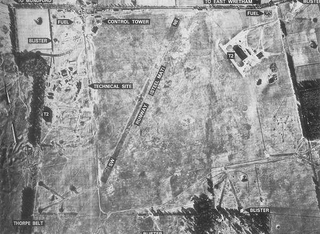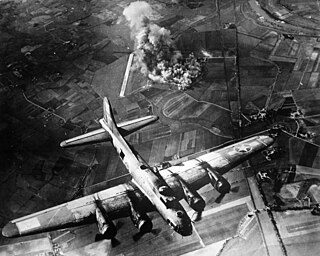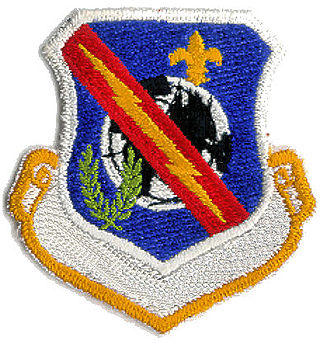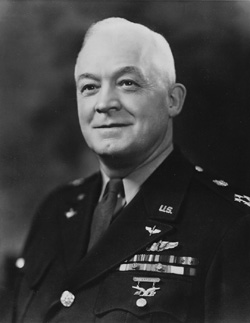
The Eighth Air Force (Air Forces Strategic) is a numbered air force (NAF) of the United States Air Force's Air Force Global Strike Command (AFGSC). It is headquartered at Barksdale Air Force Base, Louisiana. The command serves as Air Forces Strategic – Global Strike, one of the air components of United States Strategic Command (USSTRATCOM). The Eighth Air Force includes the heart of America's heavy bomber force: the Northrop Grumman B-2 Spirit stealth bomber, the Rockwell B-1 Lancer supersonic bomber, and the Boeing B-52 Stratofortress heavy bomber aircraft.

The second Schweinfurt raid, also called Black Thursday, was a World War II air battle that took place on 14 October 1943, over Nazi Germany between forces of the United States 8th Air Force and German Luftwaffe fighter arm (Jagdwaffe). The American bombers conducted a strategic bombing raid on ball bearing factories to reduce production of these vital parts for all manner of war machines. This was the second attack on the factories at Schweinfurt. American wartime intelligence claimed the first Schweinfurt–Regensburg mission in August had reduced bearing production by 34 percent but had cost many bombers. A planned follow-up raid had to be postponed to rebuild American forces.

Royal Air Force Aldermaston, or more simply RAF Aldermaston, is a former Royal Air Force station located 8 miles (13 km) east of Newbury, Berkshire and 9.8 miles (15.8 km) southwest of Reading, Berkshire, England.

The Pointblank directive authorised the initiation of Operation Pointblank, the code name for the part of the Allied Combined Bomber Offensive intended to cripple or destroy the German aircraft fighter strength, thus drawing it away from frontline operations and ensuring it would not be an obstacle to the invasion of Northwest Europe. The Pointblank directive of 14 June 1943 ordered RAF Bomber Command and the U.S. Eighth Air Force to bomb specific targets such as aircraft factories, and the order was confirmed when the Allies met at the Quebec Conference, 1943.

The Ninth Air Force (Air Forces Central) is a Numbered Air Force of the United States Air Force headquartered at Shaw Air Force Base, South Carolina. It is the Air Force Service Component of United States Central Command (USCENTCOM), a joint Department of Defense combatant command responsible for U.S. security interests in 27 nations that stretch from the Horn of Africa through the Persian Gulf region, into Central Asia.

Royal Air Force Polebrook or more simply RAF Polebrook is a former Royal Air Force station located 3.5 miles (5.6 km) east-south-east of Oundle, at Polebrook, Northamptonshire, England. The airfield was built on Rothschild estate land starting in August 1940.

Royal Air Force Podington or more simply RAF Podington is a former Royal Air Force station in northern Bedfordshire, England, 6 miles (9.7 km) south-east of Wellingborough, Northamptonshire.

Royal Air Force Grafton Underwood or more simply RAF Grafton Underwood is a former Royal Air Force station located 4 miles (6.4 km) northeast of Kettering, Northamptonshire, England.

Royal Air Force East Wretham or more simply RAF East Wretham is a former Royal Air Force station located 6 miles (9.7 km) northeast of Thetford, Norfolk, England.

Royal Air Force Shipdham or more simply RAF Shipdham is a former Royal Air Force station located 3 miles south of Dereham, Norfolk, England.

The 5th Air Division is an inactive United States Air Force unit. Its last assignment was with Strategic Air Command, based at Sidi Slimane Air Base, Morocco. It was inactivated on 15 July 1958.

The Combined Bomber Offensive (CBO) was an Allied offensive of strategic bombing during World War II in Europe. The primary portion of the CBO was directed against Luftwaffe targets which was the highest priority from June 1943 to 1 April 1944. The subsequent highest priority campaigns were against V-weapon installations and petroleum, oil, and lubrication (POL) plants. Additional CBO targets included railyards and other transportation targets, particularly prior to the invasion of Normandy and, along with army equipment, in the final stages of the war in Europe.

The 92d Operations Group is the flying component of the 92d Air Refueling Wing, assigned to the United States Air Force Air Mobility Command Eighteenth Air Force. The group is stationed at Fairchild Air Force Base, Washington.

The 80th Flying Training Wing is a wing of the United States Air Force based out of Sheppard Air Force Base in Wichita Falls, Texas.

The 97th Operations Group is a United States Air Force unit assigned to the 97th Air Mobility Wing of Air Education and Training Command. It is stationed at Altus Air Force Base, Oklahoma.

The United States Army Air Forces was the major land-based aerial warfare service component of the United States Army and de facto aerial warfare service branch of the United States during and immediately after World War II (1941–1947). It was created on 20 June 1941 as successor to the previous United States Army Air Corps and is the direct predecessor of the United States Air Force, today one of the six armed forces of the United States. The AAF was a component of the United States Army, which on 2 March 1942 was divided functionally by executive order into three autonomous forces: the Army Ground Forces, the United States Army Services of Supply, and the Army Air Forces. Each of these forces had a commanding general who reported directly to the Army Chief of Staff.

The 47th Operations Group is the flying component of the 47th Flying Training Wing, assigned to the United States Air Force Air Education and Training Command. The group is stationed at Laughlin Air Force Base, Texas.

The 405th Air Expeditionary Group was a provisional unit assigned to the United States Air Force Air Combat Command. The 405 EOG was believed to control Boeing B-1B Lancer and B-52 Stratofortress operations over combat areas in Iraq and Afghanistan.

The 325th Weapons Squadron is a United States Air Force unit assigned to the USAF Weapons School, stationed at Whiteman Air Force Base, Missouri, it is a geographically separated unit of the 57th Wing at Nellis Air Force Base, Nevada. The mission of the squadron is to provide Northrop Grumman B-2 Spirit instructional flying.

The Bombing of Yawata on the night of 15–16 June 1944 marked the beginning of the United States Army Air Forces (USAAF) strategic bombing campaign against the Japanese home islands during World War II and was the first such raid to employ strategic bombers. The raid was undertaken by 75 Boeing B-29 Superfortress heavy bombers staging from bases in China. Only 47 of these aircraft dropped bombs near the raid's primary target, the Imperial Iron and Steel Works at Yawata in northern Kyūshū, and little damage was caused. Five B-29s were lost in accidents during the operation and two were destroyed by Japanese aircraft.




















